The use of berley in saltwater can make or break your day depending on what it’s made of, and how and where it’s used.
Berley mixes can be as simple or as complex as you like. Almost everyone has an opinion on the subject, and their own special recipes for optimum success.
Berley is the regular release of small amounts of fish food into a waterway. It’s designed to attract fish, hold them in your area and trigger a more aggressive feeding response.
Just about all fish will respond to berley of some description. In the freshwater, berley might range from a dough mix with maggots to rustling bankside grass to get the grasshoppers airborne and landing in an adjacent stream.
In the salt, berley may be as bold as generating a slick in 70 metres of water to entice a mako or as simple as flicking bits of bread next to a jetty to get the garfish going.
How you go about using berley, and what you make it with, should be dictated by the water you’re fishing and the habits of the fish you’re after.
Tuna oil mixed with chook pellets is one of the easiest mixtures to concoct and its consistency can be varied to suit the conditions of the day. You can also add your own ingredients to match the baits you’re using, such as chopped pilchards or crushed mussels.
Every town has a bakery and every bakery has ‘yesterday’s bread’ for sale at a fraction of the cost of the fresh stuff. This makes very good berley for fish that feed on the surface, such as garfish and mullet.
It’s easily soaked in tuna oil to sweeten the offering, but works well enough on its own too.
Tinned cat food is a pre-packaged berley pot! It often includes fish products (fish flavoured ones anyway) and with a few holes punched in the can and a length of string tied to one end, makes a great ‘low effort’ and affordable berley pot.
Alternatively, it can be opened right up and churned through a chook pellet mix.
Some anglers visit their local co-op and get fish scraps. These are then broken up in the berley pot using a masher.
Unwanted scraps can also be minced up using a conventional hand mincer or if large quantities are required, an industrial belt driven one. This makes a fairly sloppy mixture that is best used frozen.
These are a great option if you can’t make your own. The solid varieties are commonly derivatives of chook pellets with added sweeteners or seafood scraps.
Many companies also offer bottled tuna oil or other fish oils as a concentrated additive.
The conditions on the day will dictate just how effective your berley is! Here are a few scenarios to illustrate how best to use berley to increase your catch rates.
We’re fishing for whiting on the outgoing tide in the Barwon River mouth. The tide can nudge 6 knots so tossing out chook pellets will see seagulls scoffing the lot about 100m out to sea. The current will carry your berley away from you too quickly and won’t attract fish to your bait. In fact, it will have them congregating well away from your bait.
Aim to release limited amounts of berley down at the level of the fish. One option is to tie a berley pot to your anchor. That’s fine for short sessions but if you want to check your berley pot every now and then, you’ll have to bring up your anchor. That’s a pain I can do without! I prefer to use a very heavily weighted berley pot on a separate rope that can be fixed to a rail in the cockpit, where it’s most easily accessed.
In this scenario, you want berley to be released very slowly. There are two ways of doing this. Firstly, freeze the berley so it dissolves as it defrosts. Secondly, restrict the berley pot’s openings to slow down the dilution of the mix into the water. A stocking, onion bag or fine mesh can help do this.
We’re fishing for silver trevally in Apollo Bay harbour. We have reasonably shallow water of 4 to 5m and virtually no current. Start the ball rolling with a mixture of tuna oil and chook pellets. Make it reasonably dry so you can mould it into shapes.
Create a clump about the size of a tennis ball and send it to the bottom. Next, dilute your berley so it’s quite runny and once the fish come on, just keep tainting the water with cup fulls of thin berley. This doesn’t feed the fish and because there is little or no current, it maintains the flavour in the water and keeps them in a feeding mood.
We’re in Bass Strait shark fishing in 70 metres of water. Good berley can mean the difference between a dinner of flake or baked beans. You really need to establish a constant berley trail for hours on end without a break. If your berley trail is interrupted, a shark swimming up the trail might never make it to your baits.
Punching a berley pot for just 20 minutes can be very tiring, let alone hours on end! Dean McDonald showed me a great idea that has been kept a secret for too long – frozen berley!
A heavy industrial mincer, an understanding partner, a few fishing mates and the promise of an afternoon barbeque will soon see the freezer full of berley blocks for a season’s shark fishing. Dean fills a tub with minced frames, adds some secret ingredients and transfers portions into empty 2 litre milk cartons. A stainless yabby pump is great for filling the milk containers without spilling too much.
When the time comes, just strip off the cardboard milk container and throw the contents into your berley pot whole. It lasts between 1 and 2 hours in 20 degree water. A few milk containers will do a whole day’s shark fishing and you should see the slick these things pump out!
We’re now on the local jetty chasing a few garfish, which are suckers for just about any type of berley. Grab a loaf of bread and head down to a jetty or breakwall. Crumb the bread up because this minimises seagull attacks and helps to spread it over the surface of the water. The rest of the bread can be used as bait by squashing it into doughy balls over your #10 long shank hook. Give yourself about 60cm of leader, tie on a float and toss it out amongst your floating breadcrumb berley.
You can use tuna oil and chook pellets for gars, but they need to be mixed runny so most of it either floats or remains in the top metre or so of water. This method is also very effective on mullet and you might be surprised by some of the bream that turn up too, particularly if you’re near good structure.
Most tackle shops stock sinkers and floats that can be packed with berley. Originating from freshwater coarse fishing circles, they work extremely well in the salt too.
The sinkers work well on flathead and whiting when currents are light and you don’t need a lot of weight. The floats are great for garfish.
Casting needs to be done carefully so you don’t lose the contents of your float or sinker. And remember that as the berley disperses, the float or sinker will become lighter, which might affect drift rates (for floats) and your ability to hold bottom (for sinkers).
Keen Geelong angler, Ross Winstanley, had this to say about berley.
“I hate the thought of spending money on chubs of frozen minced fish waste or mussels for berley, particularly if it attracts the wrong fish. I haven't the time to be chasing my own mussels and I don't use enough pilchards to have half a block left over. There’s no point in taking fish frames home because I don’t have a mincer.”
“Despite that, berley is beneficial if not essential, for whiting and pinkies most of the time. With whiting, I can usually get them going directly under the berley trail which, in the shallow, relatively still water I'm fishing, is not far from the back of the boat.”
“I use a combination of berley in a small mesh bag over the side of the boat. For whiting I like crushed mussels plus any seafood leftovers such as prawn heads or crayfish carcases (not as often as I’d like). Left over pipis and cut-up squid from previous trips also get added. Sometimes frozen peas too for ground bait; I find the no-name brand tends to sink better than brand names.”
“I also visit my local fish shop and collect any green prawns, squid and mussels that are past their use-by date. The downside of all this is that it attracts undersized pinkies, banjos, leatherjackets, toads and porcupine fish.”
“When fishing for pinkies and flathead, I use old pilchards for berleying the shallow water.”
“I so rarely fish in current that thin and wet berley consistencies aren’t something I bother with. I'm told that the old blokes who fish for whiting in current let the fish they hook swim about a bit and regurgitate their food before bringing them in. This effectively berleys the spot they're fishing.”
Ross’s thoughts on attracting non-target fish with berley certainly ring true for me.
On a recent trip off Torquay we heavily berleyed shallow reef areas hoping to find some big whiting. I reckon we managed to attract every wrasse, toadie, miniature pinkie and banjo from Mallacoota to Apollo Bay that night!
Berley can really make a difference to your catch rates when done properly, but it does require some preparation, consideration of conditions on the day and a bit of extra gear onboard. Most keen bait anglers will agree though, that berley is certainly worth the extra effort nine times out of ten.
Facts
Champion Bay Berley
I gave Champion Bay berley a try through March and was impressed with its performance. It might well have been the deciding factor in providing the family with a feast of King George whiting when things were a bit quiet off Queenscliff.
It had a strong odour, created a decent slick and lasted longer than other dry berleys I’ve used. It was easy to load into my plastic berley pot and there were some quite sizable chunks in the 750g bag. These larger pieces outlast the finer ingredients, which dissipate more quickly in the water.
I used it straight, but it can be added to a chook pellet mix if you want it to go further.
The liquid version comes in a generous 600ml bottle (most tuna oils are only 500ml) and was more soluble than tuna oil, which means it should saturate dry berley ingredients better if you’re bulking it out with other ingredients.
Facts
9. Champion Bay berley comes from Western Australia and is made from left over rock lobster product.
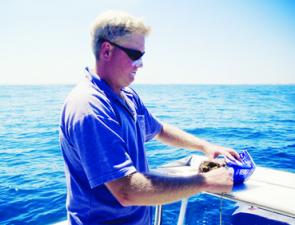
Dean McDonald opens up a milk carton of frozen home made berley.
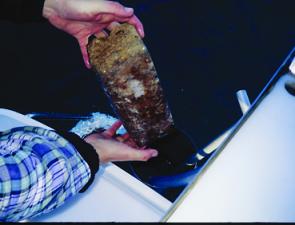
Easy and relatively clean, frozen berley blocks will last between 1 and 2 hours in 20 degree water.
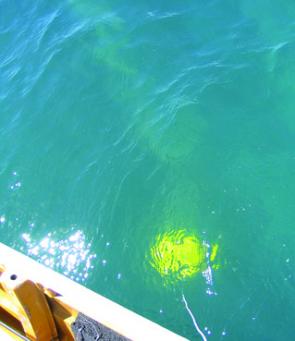
Weighting berley pots with lead can help you effectively berley deep down if that’s where your target species lives.
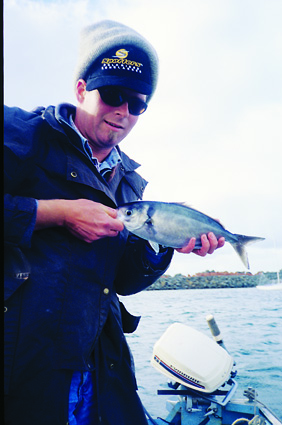
Snotty trevally in the Apollo Bay harbour are suckers for most types of berley.
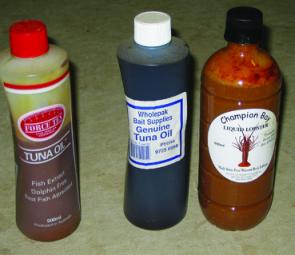
Liquid lunch in a bottle! A line up of berley additives available from most tackle stores.

Plastic berley buckets are cheap to buy and easy to use. If you want to disperse your berley more slowly then wrap some fine mesh or a stocking around inside of the pot.

Berley sinkers work well on paternoster rigs but make sure you consider the consistency of the berley you pack into them in order to achieve a good dispersal rate.





